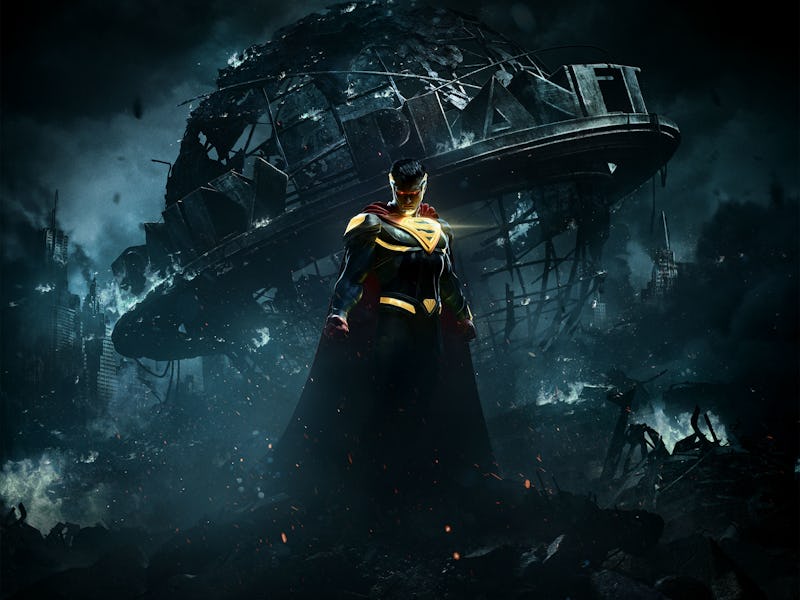Inside the Gear System for 'Injustice 2' and Esports
We spoke to 'Injustice 2' designer John Edwards about how the gear system plays out competitively.

After four years, NetherRealm Studios is taking gamers and DC Comics fans back to the arena in Injustice 2. Available now on Xbox One and PlayStation 4, Injustice 2 takes place after the defeat of a tyrannical Superman when Gorilla Grodd forms a new group, the Society, to pursue world domination. New to the series is the “gear system,” in which players can customize characters of the DC universe — Batman, Wonder Woman, and even crossovers like Sub-Zero from Mortal Kombat — and outfit them with pieces of armor that alter their playstyles. No longer will a character be inaccessible to a player because they don’t like how they behave, according to lead designer John Edwards. And it would have happened sooner because the gear system has been gestating at NetherRealm since their 2011 Mortal Kombat reboot.
“It’s something we’ve been kind of wanting to do since MK 9,” Edwards tells Inverse, but technical limitations at the time were prohibitive. “It was borne from the desire to allow players to look any way they want to.” This idea befits the superhero genre; the long history of comic books and the adapted cartoons and movies means everyone has “their” version of Batman or Superman. “These characters keep reinventing themselves over the years. So we felt it was a natural path to get in and say, ‘How cool would Superman look if he never left Krypton? Or in the future?’ It was born from that [idea].”
A screenshot of Deadshot knocking Aquaman silly in 'Injustice 2.'
The gear system is also NetherRealm’s way of trying to push boundaries in the fighting genre, which Edwards says doesn’t often reward player improvement. But players anxious about game balance, fear not. Although it wasn’t easy, NetherRealm assures the gear system is balanced in execution, because victory depends on how players simply prefer to play.
“Fighting games have always been like chess in a way. Both sides are kind of equal. But we really wanted to kind of break out of that mold and do some cool, interesting stuff,” says Edwards. His example: If a player wants a defensive Gorilla Grodd, they can outfit Grodd with gear of high health and defense. So while Grodd’s attacks may not be as strong, this customized Grodd can take a beating. “Maybe I’m not comfortable doing combos. So my best bet, I feel, is to outlast the opponent. Whereas you might just wanna get in the guy’s face and really rush him down. So maybe you sacrifice defense to go way more offensive, knowing that if something bad happens and you get close, and you can’t kill me quickly, the advantage shifts to me.”
Edwards says that previous fighting games implemented this in characters, which “locked people out” from choosing their favorites. “Maybe I wanna play Bane because I like Bane, but his playstyle doesn’t jive with me. So we allowed it where you could build your Bane in a way that feels good to you.”
Robin and Blue Beetle brawl in 'Injustice 2.'
But what about sanctioned esports? Will the gear system influence tournament play? Not really. Last week, NetherRealm announced the official “Injustice 2 Championship Series,” which will hold matches in the U.S., Europe, and Latin America for a grand prize pool of over $600,000.
To that end, NetherRealm has a Tournament Mode in the game, which makes event play headache-free. “We have an actual tournament mode that will enable or disable stats and augments to make running a tournament easier, and it will randomize the visuals of gear so players can always see newer and cooler versions of the character each time.” The goal was to have competitors on even footing, much like Edwards’s aforementioned chess metaphor. “It’s as close to balanced as you can get. Our tournament mode is essentially the way we’ve done Mortal Kombat X, Injustice, and MK 9.”
Edwards says that there are thousands of gear options in Injustice 2, and thousands more were rejected in the planning stages. Pieces were trashed if they looked too unlike the characters they were designed for. “Luckily, as a design lead, I didn’t have to come up with each individual one. I’m sure the artists wanted to punch me in the face,” Edwards jokes.
Some characters, like the Joker and Harley Quinn, have a wider zone for creativity than others. “Some of these characters, you can really push [the boundaries] a little bit because that’s their personality. Wonder Woman, Batman, Superman, they’ve traditionally not moved around too much as far as how they looked, so [their gear] fit the way you expect them to look but still have tons of variety.”
But some were question marks. Among the newcomers to the series is Swamp Thing, the humanoid elemental created by Len Wein and Bernie Wrightson for the horror comic House of Secrets in 1971. Being a big, walking plant, it wouldn’t make sense for Swamp Thing to don spandex and armor. And NetherRealm knew “early on” that Swamp Thing would be something of an issue.
“We started doing research, looking back at past versions of Swamp Thing. In the end, we settled with, ‘Okay, we can do fungus or branches out of his body. We give him a weapon, a club we can add attachments to, like stones, barbs, and spikes.’” Among all the “problem” characters, Swamp Thing “worked out great,” even if characters like him made NetherRealm worried. “Early on, we’re really kind of like, ‘Did we bite off more than we can handle?’ But the guys at the art team did a great job.”
Injustice 2 is available now.